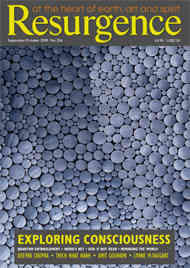To European-American biologist-photographer Carll Goodpasture, perception can mean the difference between the mundane and the magical. He has shown his tendency towards the ineffable side of things in five previously published books of photography, the most mature being his 2006 Terje Vigens Båt, which blends photos of Norway’s south coast with Ibsen’s epic poem Terje Vigen. Goodpasture’s work has been widely shown, including at the Museum of Natural History at the Smithsonian Institute, at the National Zoological Park in Washington DC, and in Oslo, Norway. And here is his latest photo-essay, Imagining Place, a vista of spiritual consciousness in the natural world as revealed in the prairie lands of the American Great Plains.
Goodpasture now lives with the painter Gro Heining in a cottage in her native bioregion of Norway, but in the late 1970s he worked for the US Department of Agriculture conducting scientific research at North Dakota State University in Fargo. He returned in the 1980s to teach art. While there, he became interested in the life of a local Native American visionary, Black Elk, who lived among his people, the Oglala Sioux, in the late 1800s, at the height of the US assault on the Indigenous tribes of the American West. It was a time of great distress, and Black Elk served by communing with the spirits of the land to offer meaning and direction. Goodpasture learned about Black Elk’s visions of ecological spirituality from John G. Neihardt’s 1931 conversation with the leader that, in 1970, became Black Elk Speaks.
With his imagination of Black Elk’s perceptiveness in mind, and his camera in hand, Goodpasture ventured into what he posited were the same forests and plains the Oglala Sioux had roamed. The resulting black-and-white photos are stunning, and comparable to the work of American Nature photographer Ansel Adams. In fact, Goodpasture uses a camera much like Adams’: a folding-view camera, the kind with legs and a black cloth over the photographer’s head – and the slowness of this approach allows him to enter into the meditative state reflected in the work.
Here is the first snow at Buffalo River; there, the winter solstice sun. Then, reflecting the human urge to find itself in the ecological, here are prairie stones waiting, a creek resting, birch trees mourning. In the end, Goodpasture coaxes us back to the human-made world. Here is a missile silo; there, a gas station. Rather than a horrific re-entry, we are treated to the same slant of camera and interplay of black, white and grey so that, instead of rejection or disgust, an inviting continuity of consciousness is proposed.
A remarkable aspect of this visual sesshin (gathering of mind) is how Goodpasture has highlighted the imagery with words the legendary Native wisdom-keeper spoke in the 1930s. This is tricky business. In the 1970s and 1980s, when droves of non-Native peoples in the US and Europe were seeking spiritual sustenance from Indigenous teachings, many Native people let it be known that such incursions consisted not only of misuse for isolating fragments of cultures meant to be in-place and whole, but of blatant appropriation. And yet Goodpasture manages to approach Black Elk’s wisdom not with the neediness or grandiosity Native people find offensive, but in respectful service to the land from which they sprang, as well as to the by now universally shared project to re-inculcate human consciousness with the magic of Nature.







